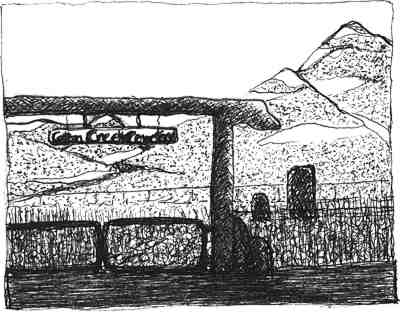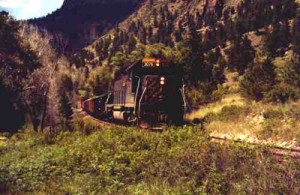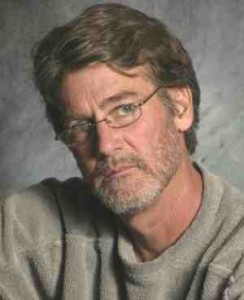Essay by John Mattingly
Local Sites – February 2006 – Colorado Central Magazine
IF YOU’RE GOING to the Sand Dunes National Park and have a spare 30 minutes, you might consider turning east off Highway 17 at Road AA (about 5 miles south of where 17 splits off from 285). Road AA is also known as Mirage Lane, pronounced Marriage Lane by locals. It’s never been clear to me whether this is a slurred mispronunciation of Mirage that became customary, or if an unusual number of weddings took place along this county road.

Personally, I’ve always thought Road AA was more appropriate for an Alcoholics Anonymous attribution than matrimony, but then I’m a few decades from qualifying as a local.
Going east on Road AA approximately 3 miles to Road 62, and 1.25 miles north on 62, will place you at the entrance to Mirage Cemetery. Though it is fenced, gated, and marked by a log entry feature, you will notice a couple of unusual things. First, there’s no cluster of headstones and markers, save for a few worn out millstones. Second, two towers of a center pivot sprinkler pass through the cemetery.
I know the story behind this pair of oddities because I managed the farm surrounding Mirage Cemetery — a farm then known as Cotton Creek Ranch that involved 22 pivots — from 1986 until 1995. When I arrived on the job, I noticed this particular center pivot had once passed through the cemetery, but the breaks in the cemetery fence where the pivot had entered and departed were blocked.
Because the cemetery occupied a cardinal, tangent point in the pivot’s circle, operating around the cemetery required stopping the pivot at one edge of the cemetery, then backtracking to the other edge. This was so inefficient that my employers asked me to negotiate passage of the pivot through the cemetery.
The cemetery representative, Mary Pavlin of Pueblo, told me she’d had problems with a previous owner of the quarter section shared by the cemetery and pivot. “They were burning weeds around the cemetery and ended up burning all the wooden markers,” Mary told me. “They destroyed the history of the plots, except for the millstones, which mark the graves of our first miller’s family. I got so mad over the loss, I fenced out that big irrigation machine. Don’t ask me to change my mind.”
I agreed with her decision with respect to previous owners, but asked her to allow that the new owners were more responsible, and even willing to make amends. “If there’s anything we can do,” I said, “please let me know.”
A month or so later, she called and agreed to meet me at the cemetery. Mary told me who all was buried there and how they had died. Most had simply failed to make it to a doctor in time.
“Fifty- sixty years ago,” she said looking north, “the roads weren’t so good, and Poncha Pass was a fright in winter when there was snow and sometimes worse in summer after a rain.”
A man who’d been kicked by his milk cow — a fetlock severed an artery in his arm — died when his buggy wheel fell off only a few miles from home. A woman in childbirth died where her car went off Poncha Pass in a blizzard. “And then Tom,” Mary said with a cocked eyebrow, “ate what was put before him. Fred over here was quick on the draw, slow on the trigger. There were Indians around here, you know.”
Standing on unmarked graves, I began to feel a bit queasy about the propriety of running a pivot over the dead, and forgot about negotiating.
“The bodies are three deep,” Mary pointed out after we had been silent for a while. “It was such a small cemetery, we had no choice.”
Before I sorted the logistics of what that meant, she said, “I see you have a backhoe over there by your house.”
“Yes, we do,” I said.
“OK, you can run the watering machine through if you’ll dig the last grave. There’s only one space left. And you’ll have to mow the grass in the last week of July each year.”
I agreed to these conditions, and the cemetery grass grew resplendently under irrigation. In the years I was manager of Cotton Creek Ranch, dozens of people visited Mirage Cemetery in the last week of July to pay respects.
And one night an old man called, his voice hoarse and broken. “Is that backhoe of yours ready?”
John Mattingly farms and writes in the Moffat non- metropolitan area.



